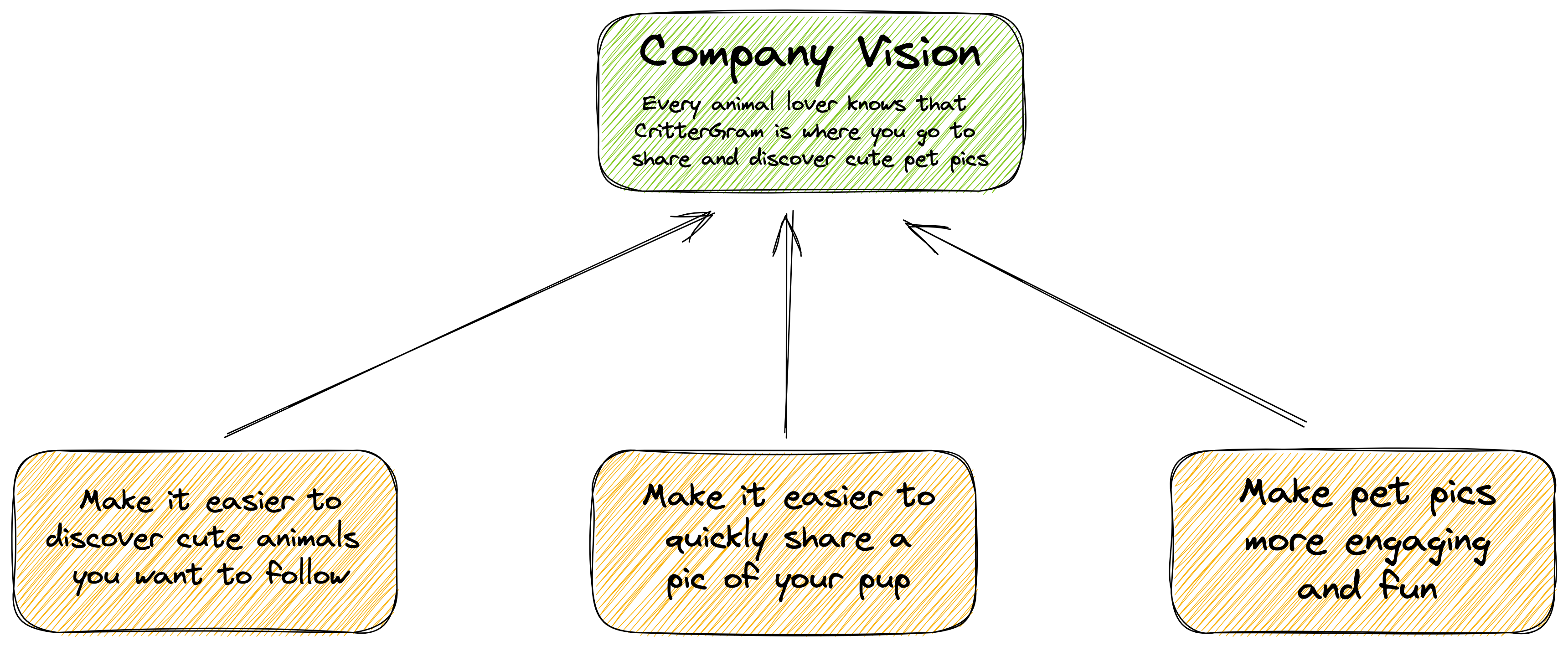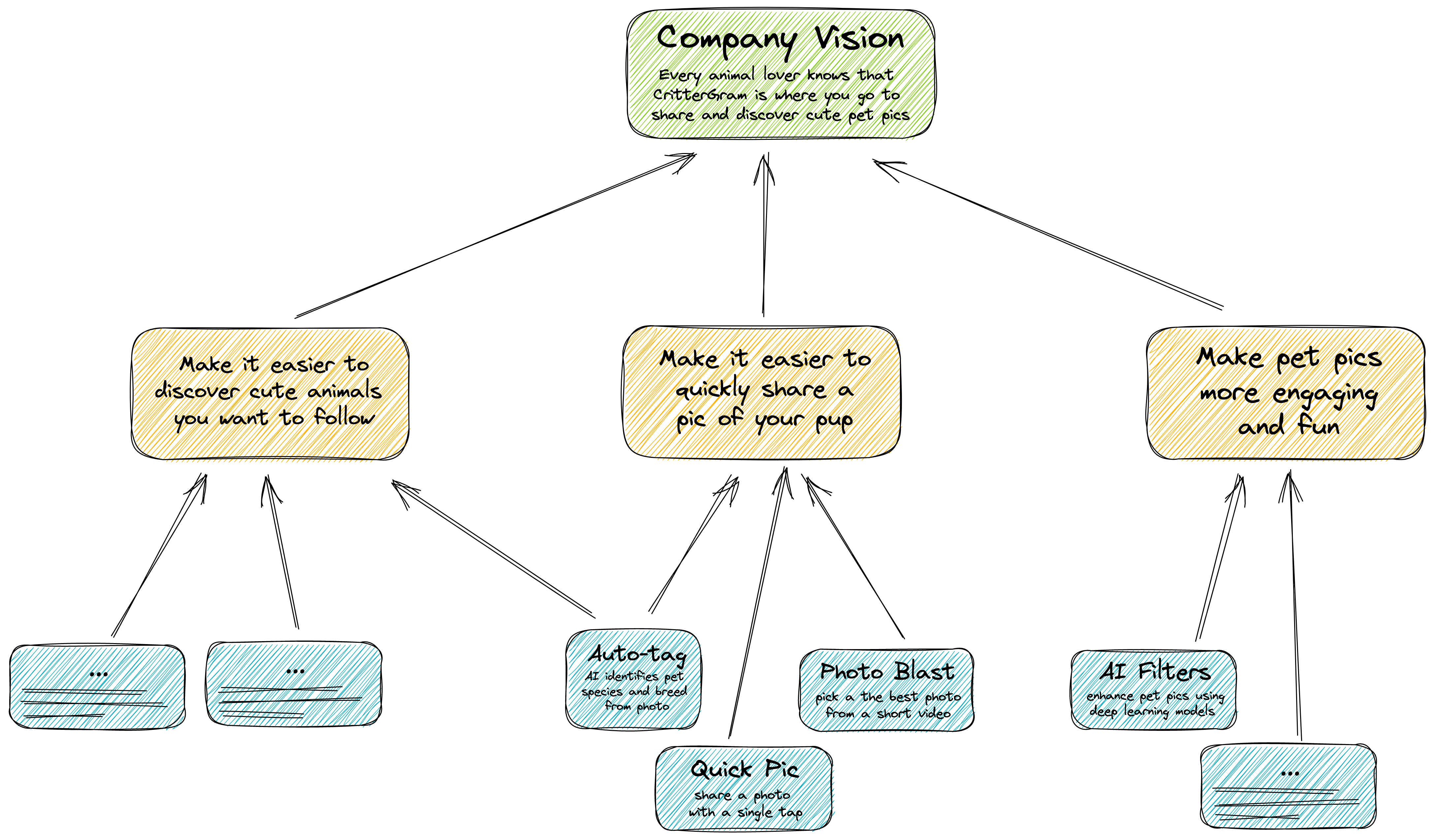Product Strategy: a Cheatsheet for Engineering Leaders
April 21, 2025
As an engineering leader at a startup, you find yourself wearing a lot of hats. Product strategy can fall onto your shoulders, even though it’s not your core expertise.
Being expected to define a clear product strategy and build a product roadmap can be pretty intimidating. Doing this well can be a huge accelerator for your teams, and neglecting it can scatter attention and waste valuable effort. You may well have been involved in this type of product strategy work before, but doing it yourself - from scratch - is a different matter.
No fear, I’m here to help! This post is an opinionated cheat sheet for an engineering leader who finds themselves in the position of faking it as a product leader. We’ll walk through what a good strategy looks like, how to create it, and how to communicate it. I’m not going to be revealing any earth-shattering innovations here; the goal is to summarize some well-proven approaches to product strategy. As an engineer without much product management experience, you’ll come away with a practical framework that will cover your bases.
What is business strategy, anyway?
A good strategy lays out the problem to be solved along with decisive opinions on how to solve that problem. At a software startup, a good strategy should articulate a long-term Vision of what the business will be, along with specific Initiatives which will be undertaken to move the business closer to that vision.
For example, at CritterGram - an imaginary pet photo sharing startup - the vision might be:
“Every animal lover knows that CritterGram is where you go to share and discover cute pet pics”.
CritterGram’s leadership has come up with three Initiatives which the company will focus on over the next 6 months in order to make progress towards this vision:
- Make it easier to discover cute animals you want to follow
- Make it easier to quickly share a pic of your pup
- Make pet pics more engaging and fun
Together, these Initiatives define CritterGram’s immediate strategy.

Just on its own, this no-frills articulation of a product strategy can be really powerful in aligning an organization’s work. Everyone understands the overall vision, and what specific areas they should be trying to improve. This lets them “focus their firepower” in those areas, and make progress towards that vision.
It can be shocking to see how often even this basic level of alignment is missed at fast-paced startups - things are changing rapidly, everyone is working super hard, and taking the time to actually define the strategy somehow doesn’t seem valuable. But without a shared understanding of strategy you’ll see people pulling in an un-coordinated variety of directions, meaning much of the impact of their work is lost. Perhaps a gnawing sense of this problem is why you’re here reading this post!
So, even if Crittergram stopped at defining their Vision and Initiatives they’d still be doing better than a lot of their peers. But they can get even more out of their strategy if they’re willing to dig one level deeper…
Tactics deliver the strategy
A good strategy communicates the overall plan while leaving flexibility in how that plan is implemented. This is the essence of Mission Command - leaders define the overall objectives but empower the folks closer to the action to decide how to achieve those objectives.
Following this principle, Crittergram leadership present their Vision and three Initiatives to their product delivery teams, and ask the teams to identify Opportunities1: ideas for product work that will contribute to these strategic Initiatives.
After some brainstorming and workshopping and iteration, the teams have come up with some great ideas. One team proposes a “quick pic” feature which lets someone share a photo with a single tap. Another Opportunity is a “photo blast” feature which lets you take a 2 second video clip and then automatically select the most flattering shot from the video. A 3rd Opportunity is the addition of AI-powered photo filters.

Note that for each Opportunity the teams have also identified how each idea contributes towards one (or maybe two) of CritterGram’s product Initiatives. These Opportunities make up the set of tactics that collectively deliver CritterGram’s strategic Initiatives.
Prioritize it, Build it
Next up, we need to look across all these Opportunities and choose which we want to prioritize. This prioritization can be done as an exercise with the CEO and other key stakeholders.
You know you’re doing this right when you come away with maybe two or three Opportunities that you want to start ASAP, and also a few Opportunities which everyone agrees are “not right now”.
This prioritization exercise can go more smoothly if you’ve some rough sizing of how much work each Opportunities might be ahead of time, even if it’s just a very quick t-shirt sizing. It’s also helpful to have some conversations with leadership ahead of time to roughly quantify the business value of each Initiative - this can help when weighing the relative priority of different Opportunities, based on which Initiatives they contribute towards.
A tree by any other name
The model we’ve used here to lay out our product strategy is quite similar to Teresa Torre’s Opportunity Solution Tree framework, although I personally learned about it as a “Lean Value Tree”. Impact Mapping is another more sophisticated approach that you could use here. It’s not too surprising that there are a variety of similar models - there’s huge value in a coherent strategy that allows anyone to connect the dots from overall business vision down to the day-to-day work done by engineers on the ground. Every high-performing startup has to figure this out at some point.
Unfortunately the names for the different levels of the tree tend to vary from framework to framework. What one person might call an Initiative another might call a Bet and a third might refer to as a Theme. What you call these things doesn’t really matter, as long as you’re consistent.
There’s a lot more to product leadership!
This post has covered the fundamentals of laying out an overall product strategy, as well as how to identify the big chunks of product delivery work which we believe will deliver on that strategy. We also touched on how to prioritize those chunks.
There’s a lot more to discuss! I’d love to dig in on more topics in this area, if there’s interest from you, my audience! Specific areas that might be valuable include building a Product Roadmap, and how to run a Product Strategy workshop.
Product Roadmapping
We’ve prioritized some Opportunities, now we need a good high-level way to plan and track that work. That’s where a Product Roadmap comes in. I can lay out a lightweight product roadmap technique that helps you plan and prioritize competing Initiatives and communicate progress to stakeholders.
Strategy Workshopping
As I mentioned earlier, the dirty secret of many startups is that there often isn’t a well-articulated product strategy. That doesn’t mean there is no strategy, it’s just that it usually lives in the CEO’s head, and isn’t well understood through the org, or even through the leadership team.
I’ve found that a few hours of collaborative planning leads to a metric ton of “a-ha!” moments as everyone starts to see the key elements of the strategy, and how it slots together. A playbook for that sort workshopping activity could come in a future post.
Get in touch
I’d love to hear from all you engineering leaders currently filling product leadership gaps. What product strategy challenges are you facing? Which topics would be most valuable for future posts?"
I’m also available for advisory consulting in this area - some of my most satisfying work centers around supporting engineering leaders who are being stretched into these sort of non-engineer responsibilities.
Either way, let’s chat!
-
epics, solutions, projects, call them what you will. ↩︎